2007 CHEVROLET CORVETTE spare tire
[x] Cancel search: spare tirePage 384 of 488
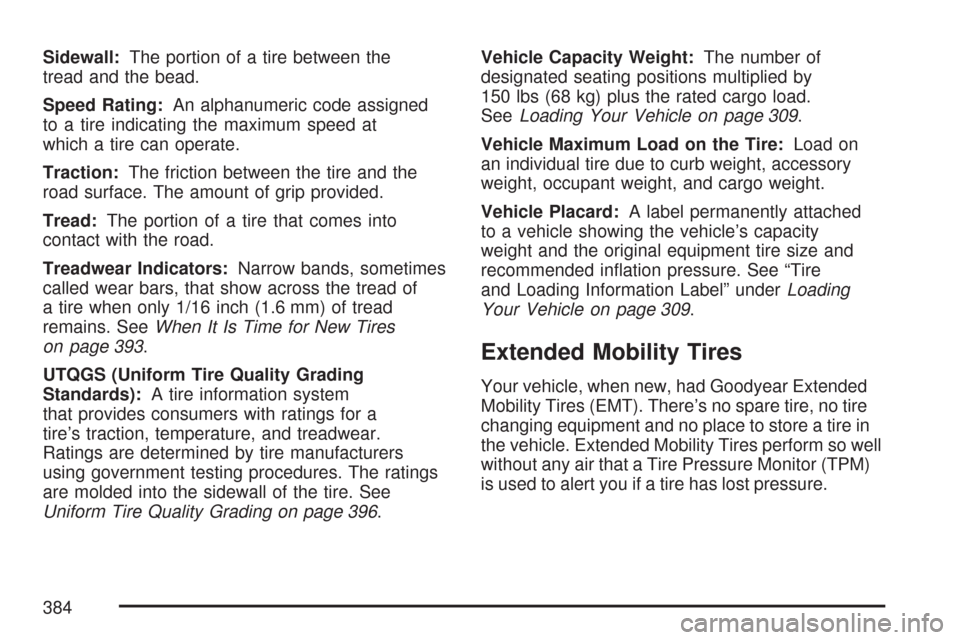
Sidewall:The portion of a tire between the
tread and the bead.
Speed Rating:An alphanumeric code assigned
to a tire indicating the maximum speed at
which a tire can operate.
Traction:The friction between the tire and the
road surface. The amount of grip provided.
Tread:The portion of a tire that comes into
contact with the road.
Treadwear Indicators:Narrow bands, sometimes
called wear bars, that show across the tread of
a tire when only 1/16 inch (1.6 mm) of tread
remains. SeeWhen It Is Time for New Tires
on page 393.
UTQGS (Uniform Tire Quality Grading
Standards):A tire information system
that provides consumers with ratings for a
tire’s traction, temperature, and treadwear.
Ratings are determined by tire manufacturers
using government testing procedures. The ratings
are molded into the sidewall of the tire. See
Uniform Tire Quality Grading on page 396.Vehicle Capacity Weight:The number of
designated seating positions multiplied by
150 lbs (68 kg) plus the rated cargo load.
SeeLoading Your Vehicle on page 309.
Vehicle Maximum Load on the Tire:Load on
an individual tire due to curb weight, accessory
weight, occupant weight, and cargo weight.
Vehicle Placard:A label permanently attached
to a vehicle showing the vehicle’s capacity
weight and the original equipment tire size and
recommended in�ation pressure. See “Tire
and Loading Information Label” underLoading
Your Vehicle on page 309.
Extended Mobility Tires
Your vehicle, when new, had Goodyear Extended
Mobility Tires (EMT). There’s no spare tire, no tire
changing equipment and no place to store a tire in
the vehicle. Extended Mobility Tires perform so well
without any air that a Tire Pressure Monitor (TPM)
is used to alert you if a tire has lost pressure.
384
Page 389 of 488
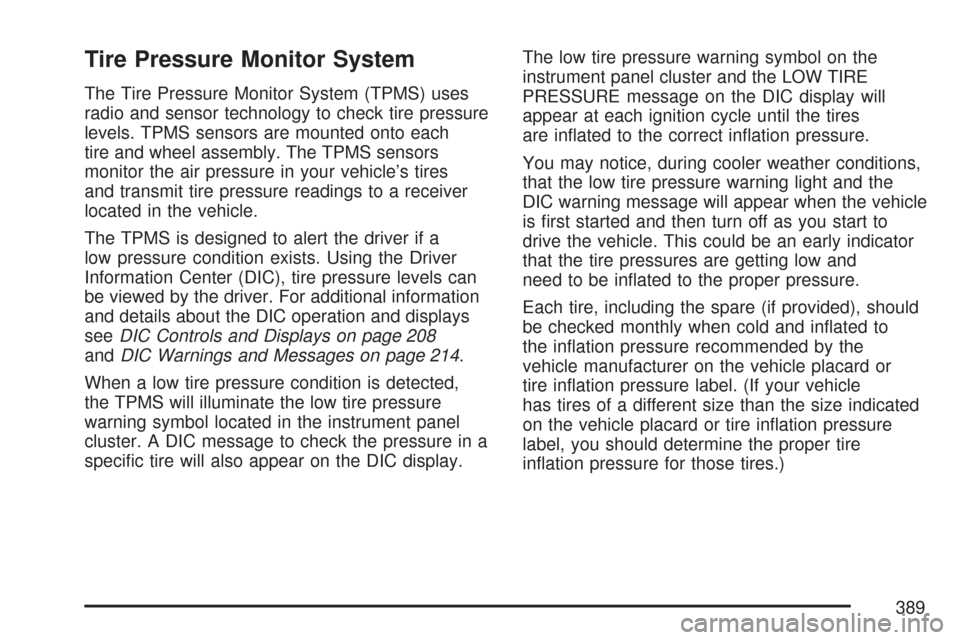
Tire Pressure Monitor System
The Tire Pressure Monitor System (TPMS) uses
radio and sensor technology to check tire pressure
levels. TPMS sensors are mounted onto each
tire and wheel assembly. The TPMS sensors
monitor the air pressure in your vehicle’s tires
and transmit tire pressure readings to a receiver
located in the vehicle.
The TPMS is designed to alert the driver if a
low pressure condition exists. Using the Driver
Information Center (DIC), tire pressure levels can
be viewed by the driver. For additional information
and details about the DIC operation and displays
seeDIC Controls and Displays on page 208
andDIC Warnings and Messages on page 214.
When a low tire pressure condition is detected,
the TPMS will illuminate the low tire pressure
warning symbol located in the instrument panel
cluster. A DIC message to check the pressure in a
speci�c tire will also appear on the DIC display.The low tire pressure warning symbol on the
instrument panel cluster and the LOW TIRE
PRESSURE message on the DIC display will
appear at each ignition cycle until the tires
are in�ated to the correct in�ation pressure.
You may notice, during cooler weather conditions,
that the low tire pressure warning light and the
DIC warning message will appear when the vehicle
is �rst started and then turn off as you start to
drive the vehicle. This could be an early indicator
that the tire pressures are getting low and
need to be in�ated to the proper pressure.
Each tire, including the spare (if provided), should
be checked monthly when cold and in�ated to
the in�ation pressure recommended by the
vehicle manufacturer on the vehicle placard or
tire in�ation pressure label. (If your vehicle
has tires of a different size than the size indicated
on the vehicle placard or tire in�ation pressure
label, you should determine the proper tire
in�ation pressure for those tires.)
389
Page 396 of 488
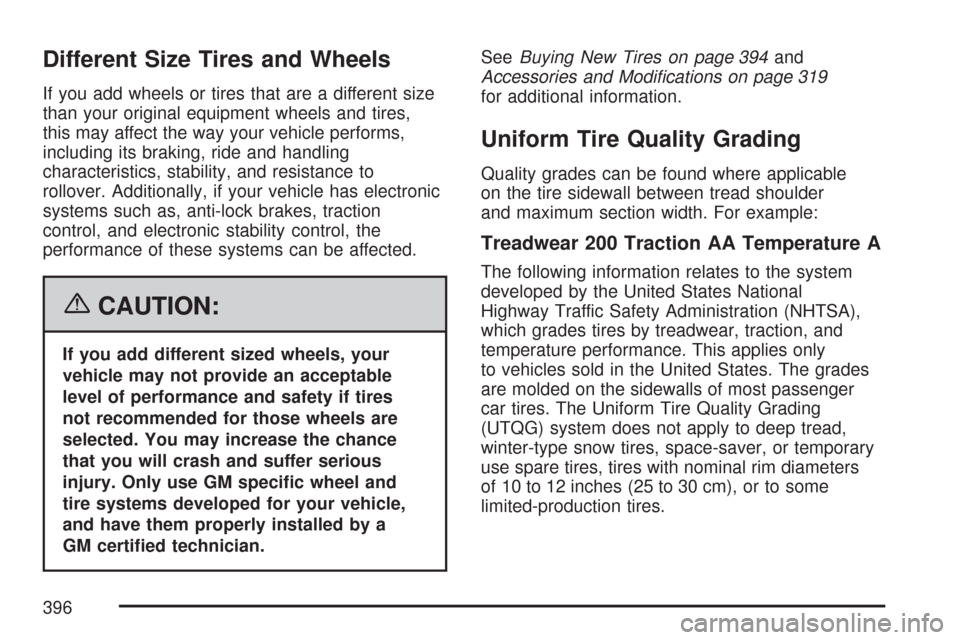
Different Size Tires and Wheels
If you add wheels or tires that are a different size
than your original equipment wheels and tires,
this may affect the way your vehicle performs,
including its braking, ride and handling
characteristics, stability, and resistance to
rollover. Additionally, if your vehicle has electronic
systems such as, anti-lock brakes, traction
control, and electronic stability control, the
performance of these systems can be affected.
{CAUTION:
If you add different sized wheels, your
vehicle may not provide an acceptable
level of performance and safety if tires
not recommended for those wheels are
selected. You may increase the chance
that you will crash and suffer serious
injury. Only use GM speci�c wheel and
tire systems developed for your vehicle,
and have them properly installed by a
GM certi�ed technician.SeeBuying New Tires on page 394and
Accessories and Modi�cations on page 319
for additional information.
Uniform Tire Quality Grading
Quality grades can be found where applicable
on the tire sidewall between tread shoulder
and maximum section width. For example:
Treadwear 200 Traction AA Temperature A
The following information relates to the system
developed by the United States National
Highway Traffic Safety Administration (NHTSA),
which grades tires by treadwear, traction, and
temperature performance. This applies only
to vehicles sold in the United States. The grades
are molded on the sidewalls of most passenger
car tires. The Uniform Tire Quality Grading
(UTQG) system does not apply to deep tread,
winter-type snow tires, space-saver, or temporary
use spare tires, tires with nominal rim diameters
of 10 to 12 inches (25 to 30 cm), or to some
limited-production tires.
396
Page 406 of 488
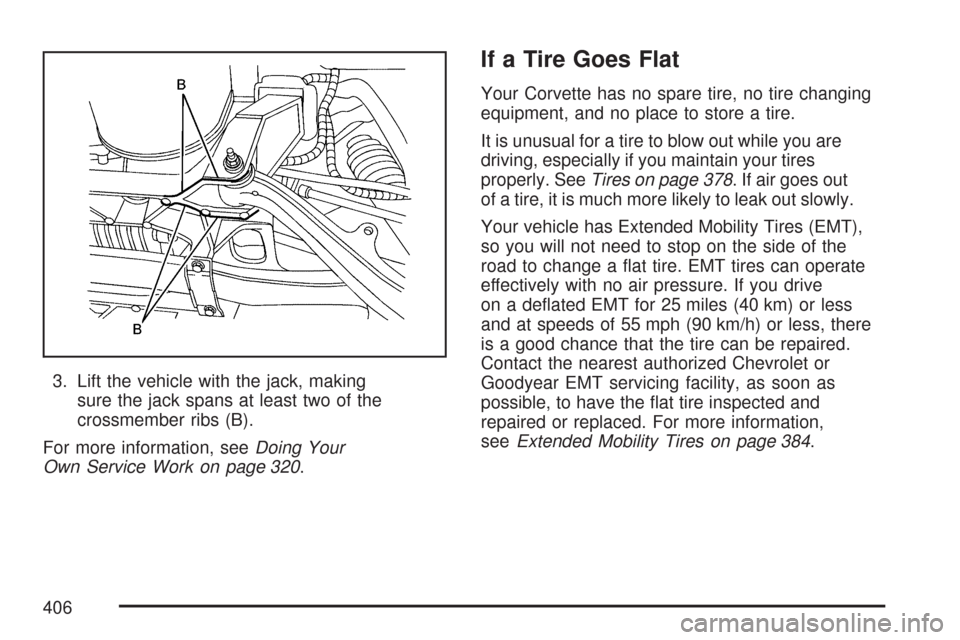
3. Lift the vehicle with the jack, making
sure the jack spans at least two of the
crossmember ribs (B).
For more information, seeDoing Your
Own Service Work on page 320.
If a Tire Goes Flat
Your Corvette has no spare tire, no tire changing
equipment, and no place to store a tire.
It is unusual for a tire to blow out while you are
driving, especially if you maintain your tires
properly. SeeTires on page 378. If air goes out
of a tire, it is much more likely to leak out slowly.
Your vehicle has Extended Mobility Tires (EMT),
so you will not need to stop on the side of the
road to change a �at tire. EMT tires can operate
effectively with no air pressure. If you drive
on a de�ated EMT for 25 miles (40 km) or less
and at speeds of 55 mph (90 km/h) or less, there
is a good chance that the tire can be repaired.
Contact the nearest authorized Chevrolet or
Goodyear EMT servicing facility, as soon as
possible, to have the �at tire inspected and
repaired or replaced. For more information,
seeExtended Mobility Tires on page 384.
406
Page 459 of 488
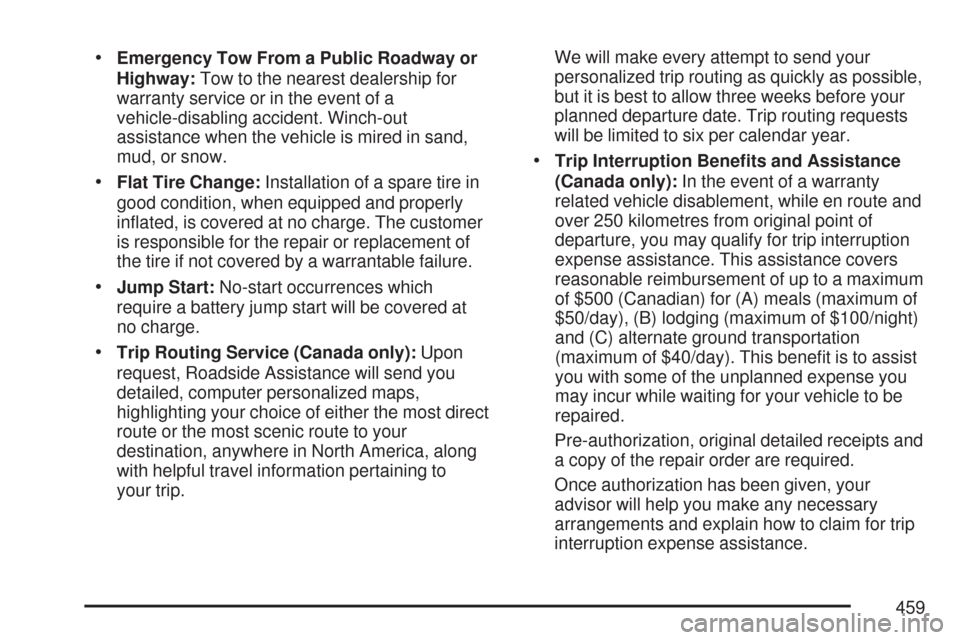
Emergency Tow From a Public Roadway or
Highway:Tow to the nearest dealership for
warranty service or in the event of a
vehicle-disabling accident. Winch-out
assistance when the vehicle is mired in sand,
mud, or snow.
Flat Tire Change:Installation of a spare tire in
good condition, when equipped and properly
in�ated, is covered at no charge. The customer
is responsible for the repair or replacement of
the tire if not covered by a warrantable failure.
Jump Start:No-start occurrences which
require a battery jump start will be covered at
no charge.
Trip Routing Service (Canada only):Upon
request, Roadside Assistance will send you
detailed, computer personalized maps,
highlighting your choice of either the most direct
route or the most scenic route to your
destination, anywhere in North America, along
with helpful travel information pertaining to
your trip.We will make every attempt to send your
personalized trip routing as quickly as possible,
but it is best to allow three weeks before your
planned departure date. Trip routing requests
will be limited to six per calendar year.
Trip Interruption Bene�ts and Assistance
(Canada only):In the event of a warranty
related vehicle disablement, while en route and
over 250 kilometres from original point of
departure, you may qualify for trip interruption
expense assistance. This assistance covers
reasonable reimbursement of up to a maximum
of $500 (Canadian) for (A) meals (maximum of
$50/day), (B) lodging (maximum of $100/night)
and (C) alternate ground transportation
(maximum of $40/day). This bene�t is to assist
you with some of the unplanned expense you
may incur while waiting for your vehicle to be
repaired.
Pre-authorization, original detailed receipts and
a copy of the repair order are required.
Once authorization has been given, your
advisor will help you make any necessary
arrangements and explain how to claim for trip
interruption expense assistance.
459